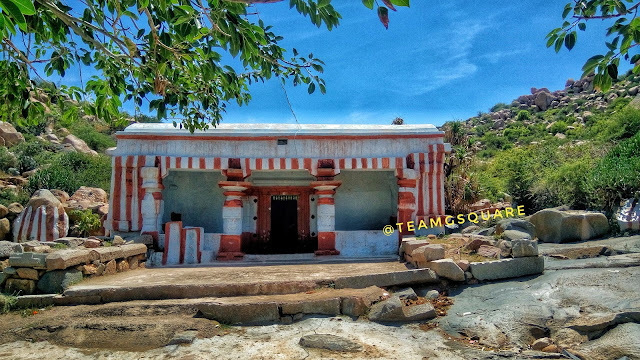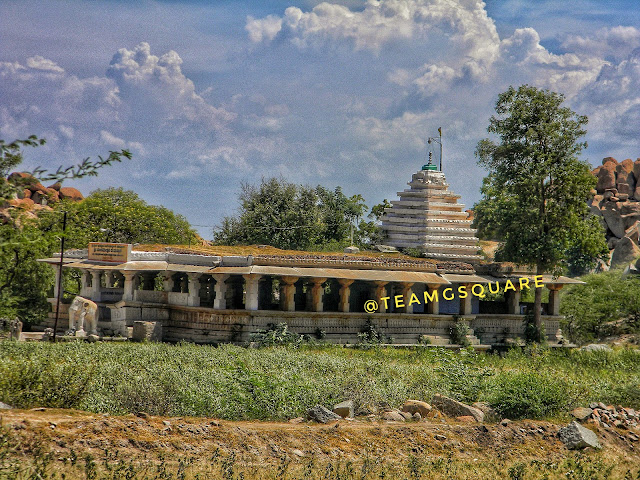 |
| A Panoramic View of Kurugodu Fort, Town and Hills |
Though traveling to Kurugodu was fairly regular when I was in Bellary, we could never manage to make enough time for exploring this place. The
'Hill Fort of 'Kurugodu' has always been inviting and many of our travel and historical books speak in volumes
about it. The level of eagerness to explore Kurugodu reached its highest at one point and culminated with us planning a road trip to Bellary during the holidays of Deepavali, last year. Trust us! This place undoubtedly exceeded our expectations. Our previous day was
quite exciting, with the highlight of the day being the
prehistoric anthropomorphic sites of Kumathi and Hulikunte. This day, we planned to explore the prehistoric sites of
Sanganakallu and Kuppagallu and in anticipation of a really hot day, we started quite
early and reached Sanganakallu. As Mr. Ramadasa, our guide for the day who knew every stone of Sanganakallu was held up with other work and promised to meet us the next day, we decided to go ahead to the next place on our list, Kurugodu.
 |
| A Bird's Eye View of Shiva Mandapa |
History of Kurugodu and Kurugodu Fort: Kurugodu
is believed to have been a part of the Kishkindha kingdom ruled by the monkey brothers Vali and
Sugreeva during the Treta Yuga (period when Lord Rama ruled the earth). Later in the Dwapara Yuga, this place became the capital of the Kuntala kingdom ruled by the great king
Chandrahasa. The town of Kurugodu, surrounded by many small hillocks, proved an ideal environment for the then prehistoric settlement. There is ample evidence given by archaeologists in the form of artifacts to prove that this site was once occupied by prehistoric men. A few cave paintings
found here can be traced back to the Bronze Age, with the others belonging to the Iron
Age. Though there are no records of Kurugodu's association with the Mauryan empire, findings from the Ashokan edicts at Nittur and Udegola which are in close proximity to Kurugodu confirm that Kurugodu was once under the rule of the Mauryan kingdom. An inscription found here dated to around 2nd century AD confirms that this place was also under the rule of the Satavahanas between 2nd and 3rd centuries AD. Subsequently, it came under the control of the Badami Chalukyas after which it gave rise
to one of the lesser know dynasty, the Sindhs of Kurugodu. The Sindhs ruled
Kurugodu from 7th century till the end of the 12th century, with their
descendants seen living even now at Kurugodu. King Ariballi
Dagra established the Kurugodu Sindh Kingdom followed by Udayaditya, Chokarasa,
Rachamalla I (the most successful king of this dynasty), Rachamalla II and
Veerakalidevarasi. The fort of Kurugodu was built by the Sindh kings way
back in the 10th century and was later improved by the Vijayanagara Kings. This fort is four tiered, with its bottom most tier of fortification encircling the entire
town of Kurugodu and its surrounding hillocks. At a later stage, Hyder Ali captured this
fort and post the death of Tippu Sultan, it was left abandoned.
 |
| Kurugodu Fort Walls |
 |
| Bird's Eye View of Hale Kurugodu |
 |
| Tungabhadra Canal Traversing Across Paddy Fields |
 |
| Kurugodu Fort |
Having been to Kurugodu many times and hence being familiar with its surroundings, we easily found a decent place to park our vehicle and reached the
base of the hill. Hereon, two men volunteered to accompany us and guide us along. They informed us about the presence of two routes, one laid with proper steps
and the other with a rough path through thorny shrubs, which turned slippery at times. For us, taking the the tougher route was quite an obvious choice. The climb was slightly difficult, though a short one and we reached
the first tier of fortification from where there were two diversions, one leading to the Shiva mandapa
and the second to the next level of fortification. Reaching Shiva mandapa was quite tricky. It is a small mandapa housing a beautiful Shiva Linga, installed by the Sindh kings who were staunch followers of Veerashaiva dharma. The
climb from here towards the second tier was quite easy. There is a temple dedicated to Lord
Anjaneya with an inscription carved on stone, of the Vijayanagara Kings. From the
top of this hill, we were able to spot many temples on the other side of Kurugodu, and upon inquiring, our guide informed us about Hale Kurugodu or Old Kurugodu, which was once a prosperous town under
the Sindhs, but now is in ruins and shambles. They gave us all the details of the
temples there. We explored the remains of the fort, most of which were still intact.
There are many interesting balancing rocks here. Our descent was quick and we
asked our guides if they were also interested in showing us around Hale Kurugodu. Their response was negative and they also went on to advise us not to explore that side of the place as it had turned into a drunkards den and would be unsafe. We thanked our guide and bade them
good bye. We stopped by a small shop to buy some snacks and prepare food for our
little one. We bought a few fruits here for which Kurugodu is known for. Kurugodu
and its surroundings are well known for the excellent quality of Pomegranate, Fig and Papaya they grow, most
of which are exported.
 |
| Balancing Rock inside Kurugodu Fort |
 |
| An Inscription Outside Lord Anjaneya Temple |
 |
| Lord Anjaneya |
 |
| Balancing Act by Rocks |
 |
| Lord Anjaneya Temple and Fort Walls |
 |
| Lord Shiva |
We decided to explore the temples which we saw
from atop the hill and proceeded further. We found ruins of many
temples here and a little further on a rock we spotted some red colored paintings. We parked our vehicle to investigate the place and to our surprise, they were indeed prehistoric
paintings. We were able to identify the paintings of hyena, bulls, people and many other worn out
paintings. So excited we were! It seemed for a second like it was our own discovery! We explored more around this area with an expectation of finding other paintings, but
no luck. There was a person working nearby this site and on inquiring him about the presence of any other such paintings around, he looked blank and admitted of being totally unaware about them. HeyI requested him to come along to the rock where we saw the paintings to know if he could recollect having seen similar paintings elsewhere, but his answer was negative. He went on to confess that he never knew about these
paintings and its significance, but will keep in mind the same from now on. He suggested us to see a cave temple with some carvings of kings a little further. We
thanked him and carried on with our explorations.
 |
| Prehistoric Rock Shelter, Hale Kurugodu |
 |
| Prehistoric Cup-marks |
 |
| Painting Depicting Hyena |
 |
| Unidentifiable Cave Paintings |
To be continued…..





















































